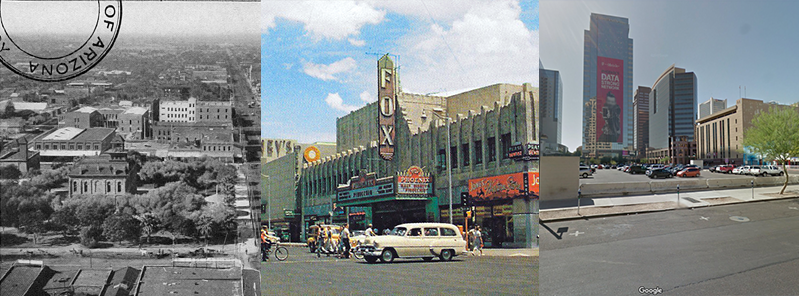
09 Mar Block 23: The Past, Present, and Future of Downtown
For the past two years, Downtown Phoenix has hosted the pre-event celebrations for both the Super Bowl and College Football Championship. These activities have centered on an asphalt parking lot in the heart of our city. This is “Block 23” on the original town map from 1885 and it is bound by Jefferson Street, Washington Street, First Street, and Second Street.
Now that the big events are over, development rumors for this block are again starting to circulate. However, before painting a new picture of what this block could be, it is important to know what this block once was: the original town plaza.
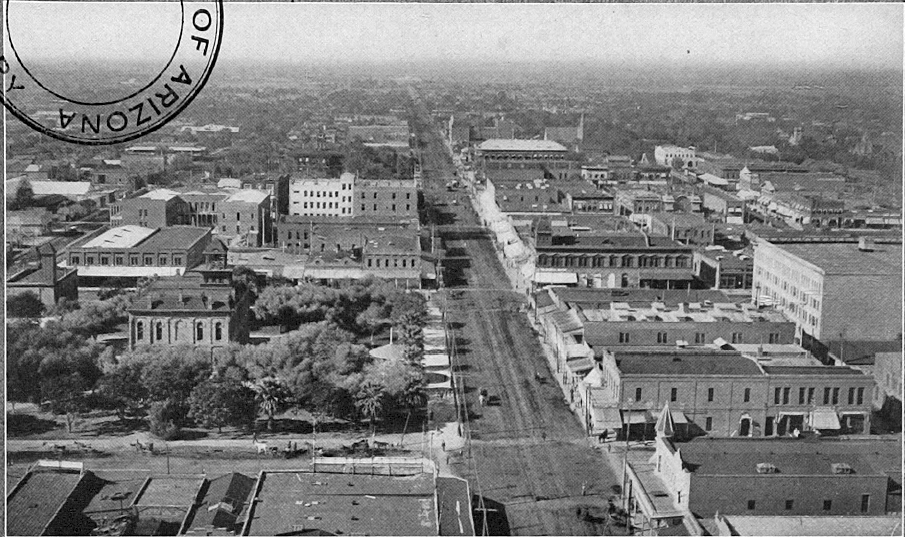 Block 23 in 1909
Block 23 in 1909

A lithograph of the public plaza at Block 23, created by C. J. Dyer in 1885
A Timeline of Block 23
1800’s – 1920’s:
William Hancock’s original town plan set aside two blocks for civic functions: block 76 for the courthouse and block 23 for the plaza. While some southwest cities were planned using a Spanish grid system—with a plaza at the 0,0 street coordinates—Hancock planned Phoenix based on a scaled down Philadelphia model. While the plaza at Block 23 does not show up in any of the few photos from that time, it does show up in the official 1885 town sketch. This was Phoenix’s own version of Philadelphia’s Washington Square, and the site where in 1879 over 400 Phoenicians conducted Wild West justice by hanging two alleged murderers.[1]
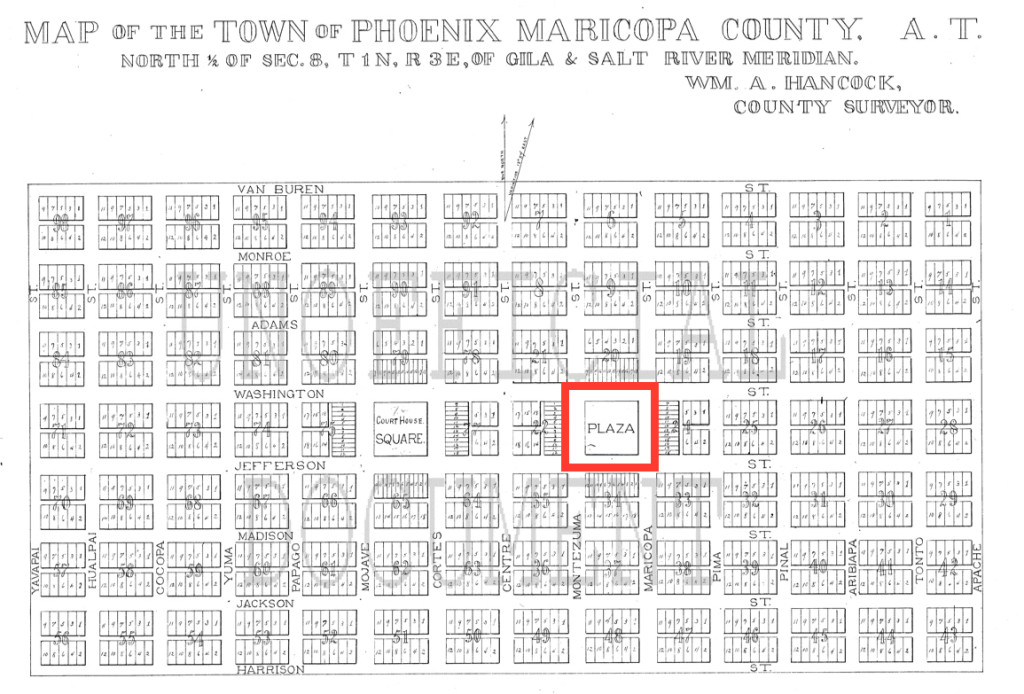
Original map of Phoenix from 1881, Block 23 highlighted as Plaza
In 1887, a voter-approved bond was passed, funding the construction of the original City Hall at the center of the plaza. The vote occurred only after a long debate by “some shortsighted private interests, with feelings that the public squares were too valuable for governmental or recreational use and insisted on subdividing them for business blocks.”[2]
City Hall was built despite these objections and became the tallest building in Phoenix. This new building was used for both City and Territorial business until the existing State Capitol building was finished. There are many pictures of the block from this period, and despite the building at its center, the original plaza design stayed basically intact.
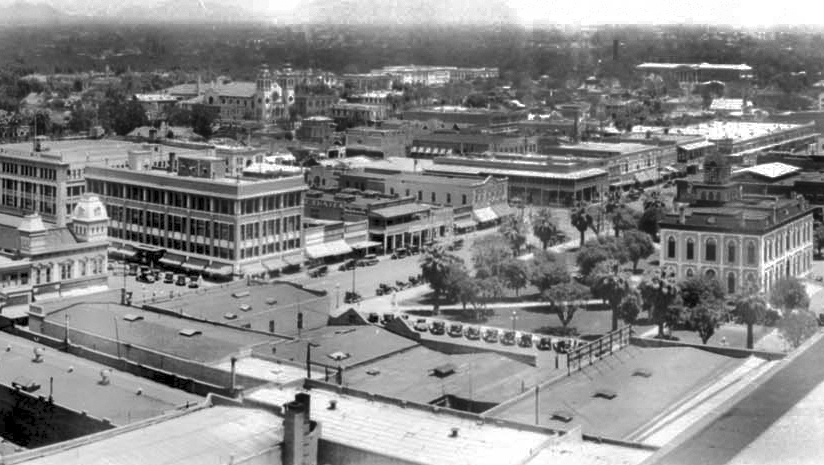
Washington Street looking Northeast to Block 23, 1920
1930’s – 1950’s
In 1931, once the construction of the “Old” City Hall at 1st Avenue and Washington (Block 76) was complete, Block 23 was sold to a private developer for a new theater. What the developer built has been described as one of the most ornate Art-Deco movie theaters in the country. This was the location of the Fox Theatre which many argue was far superior to the now meticulously preserved Orpheum Theater. Later in 1953, the downtown J.C. Penney’s store was also built on this same block.
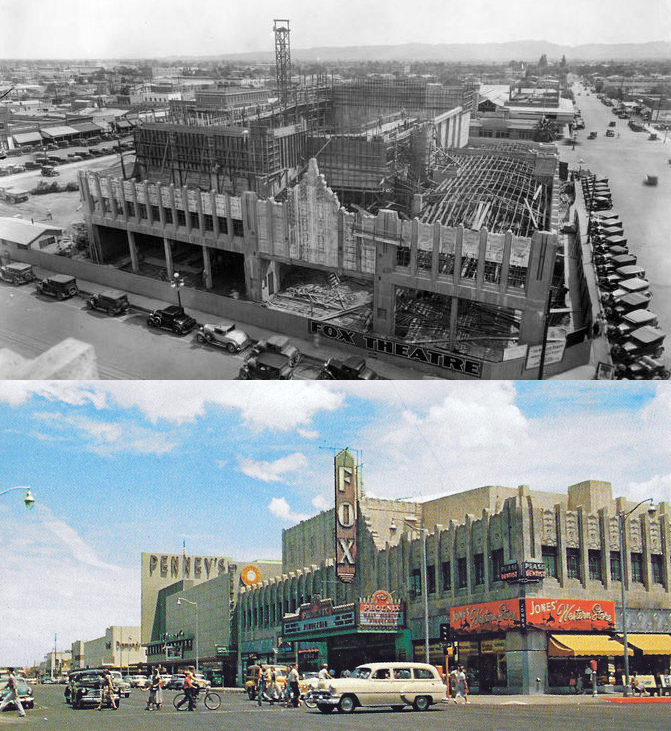
Top – Fox Theatre construction (30’s) & Bottom – Bustling street with Fox (50’s)
1990’s – Today
Over one hundred years after the original City Hall was constructed on this site, the City of Phoenix once again controlled Block 23. However, with the 1974 construction of Patriots Square Park at the city’s 0,0 intersection, there was no need for another downtown plaza and in 1992, the Phoenix City Council made a deal.
In an agreement between the Federal Government, Colliers International, and City of Phoenix, the City acquired the buildings and part of the land that now form Steele Indian School Park at North Central Avenue and Indian School Road. The rest of the park land was acquired in a second agreement between the City and Colliers in exchange for Block 23 and the current Colliers Center property. With the Fox Theater long gone, the J.C. Penney’s building was demolished leaving only a subterranean parking garage and the lot we see today.
The loss of Patriots Square Park, regardless of the terrible 1986 redesign, still lingers foul in the minds of many Phoenicians. The current CityScape rendition, while a good corporate plaza, is far from a point of public pride, and it continues to be a point of tension between parties involved. The construction of Civic Space Park in 2008 sitting just a few blocks outside of the original town site was one of the City’s best decisions and continues to serve residents, ASU, and non-downtowners well.
This however does not solve the fact or problem that Phoenix does not have a central focus or gathering spot within the original townsite. The central plaza of our city has three times been sold or re-modeled for development interests, and yet now there is an empty parking lot at its original historic location.

Patriots Square Park in the 70’s (left) and 80’s
What Next?
With the success of recent large public functions on Block 23 and negotiations on a new sports arena deal pending, now is an excellent opportunity for the City to show that it values public institutions as much as private development initiatives. The resurgence of Downtown Phoenix is here, and we must work today to secure the urban public spaces truly great cities are remembered for. While Block 23 development speculations may actually come to fruition this time, it could also continue to be an asphalt lot. We need to leverage this opportunity in order to try and regain some part of the original city planners vision.
Pride in a city starts with its public spaces and a city’s public plazas are instrumental for positive civic engagement. What a community values is what it believes important enough to hold in “common.” We Phoenicians like to pretend that this is a new city, but the truth is we are far beyond any adolescent years, and Block 23 tells us a lot about the life of our city through these development years.
Phoenix has a soul and Phoenix has a history that this soul was built upon. Cities have very few opportunities to reclaim their past. In this case, I hope by remembering what Phoenix was we can help influence what Phoenix can be. It is time to be a city that better prioritizes public funds for re-building the public realm, before we consider using public funds to finance a new downtown sports arena. At a minimum, I hope this post about what Phoenix had triggers a conversation about what we now want.

Block 23 today
[1] Talton 23
[2] Phoenix 27
Photos:
- Downtown Phoenix was the epicenter of Super Bowl fan activities in 2015. (Photo: azcentral.com)
- Thanks to Brad Hall for the scans of the McCulloch Brothers Inc. Photographs, 1884-1947 – https://repository.asu.edu/collections/244
- Far right header image of Super Bowl Central from AZCentral.com
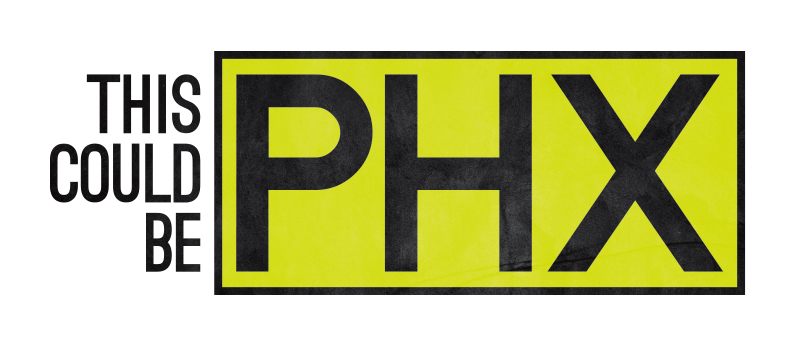



willnovak
Posted at 10:01h, 09 MarchAwesome write up, some really cool historic pics I haven’t seen! I agree we need a real central square in the CBD. However, Block 23 wouldn’t be my choice. I’d rather see the City leverage that land for high rise development, hopefully with nightlife on the ground floor to build off the existing nightlife along Washington. There are few city owned lots downtown that can be developed to a really maximum height, so we need to take advantage of the ones we have.
My dream lot for a public space is the lot bounded by 3rd Ave, 4th Ave, Washington and Jefferson. It’s currently a city owned parking garage, adjacent to Cesar Chavez Plaza. By demolishing that garage and expanding & improving Cesar Chavez plaza we could have a great public space. As LRT expands to the Capitol, there will hopefully be a stop at 4th Ave. This would connect the new plaza on multiple sides by transit. Additionally, Union Station, which will hopefully once again service passenger rail would open right onto this expanded Cesar Chavez Plaza, a nice welcome to the city for folks arriving via commuter, intercity rail or Amtrak.
james skinner
Posted at 15:05h, 13 MarchWill, that would make too much sense. 🙂 I love how it would connect to the various pocket parks on the govt. building lots, almost creating the “connected oasis” that was hyped up so much years ago. Unfortunately, the County and Federal presence in this area really ruined this part of downtown, and I don’t know if it can be repaired. Even assuming a miracle happens and Union Station serves passenger rail, the two jails across the street make it nearly impossible to expect any sort of private investment beyond bail bonds’ stores. The “plaza” created near the newest Courts Tower is ridiculous and claustrophobic. And, the Sandra Day O’Connor monstrosity needs no comment. I’d be afraid that a park in this location would then end up with a similar fate to PSP as there isn’t much potential for development surrounding it that would add users and eyes.
I still think it’s a great idea because, in theory, all of those issues *could* be fixed. The older of the two jails at least could be demolished, as could the older Courts buildings and a “Plaza de Maricopa” type mixed-use tower built with an expanded Madison Street mall, the Barry Goldwater Museum, and retail along the street. Sandra is surrounded by empty space; no reason retail or office space couldn’t be added, is there? And, Wells Fargo could add actual retail on its ground floor (move the museum into a larger integrated history museum; add a nice upscale wine bar to drink at before a show at the Orpheum, etc.). The newer jail, though… well, maybe criminal justice reform will render it useless? I’m not sure. Should have never been built. 🙁
Chuck
Posted at 06:03h, 17 MarchHadn’t seen these old pics beofre! Interesting post, but as it goes for the future, personally I hope that the sports arena deal will fall apart. It’s simply not in the interests of the general public.